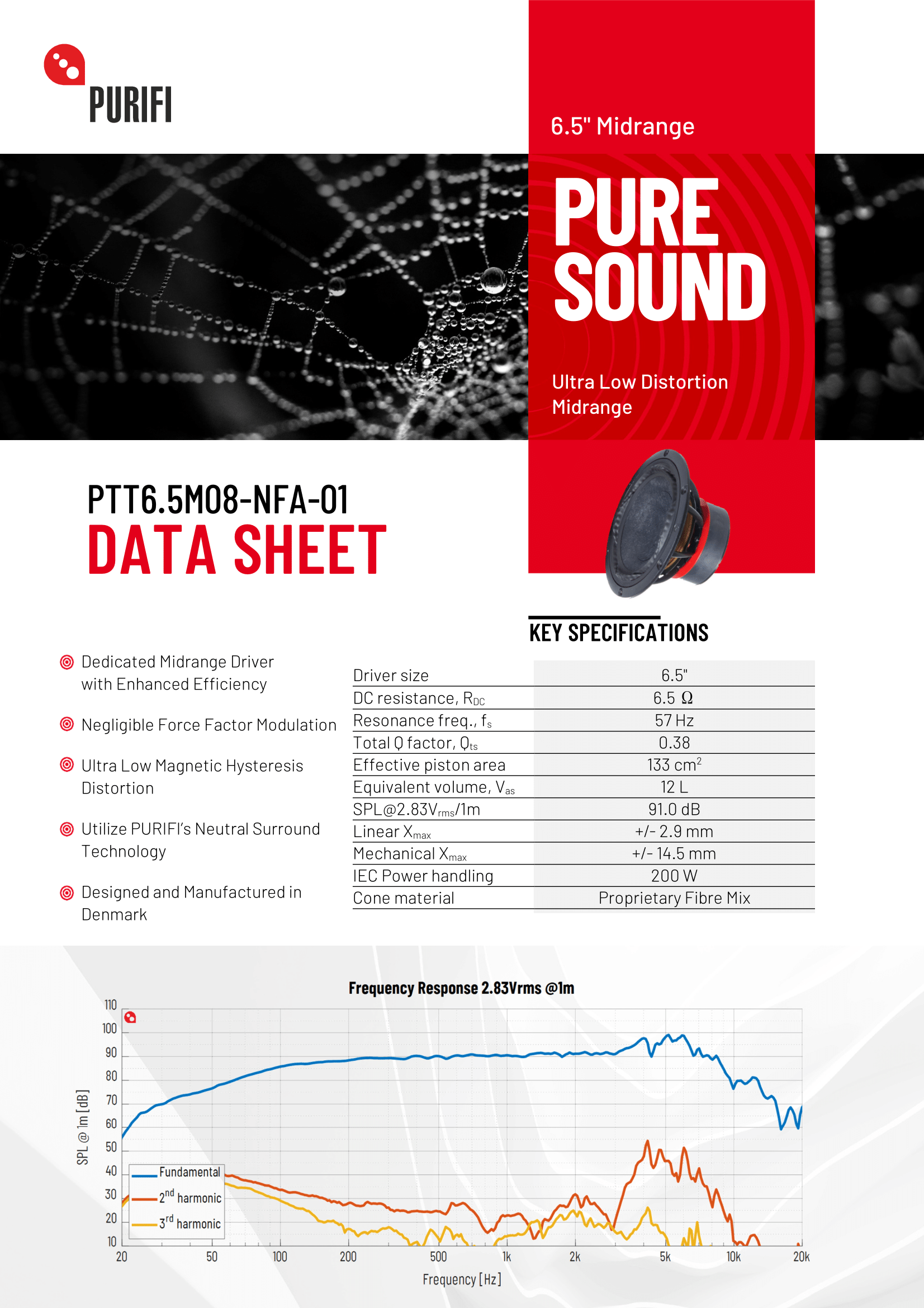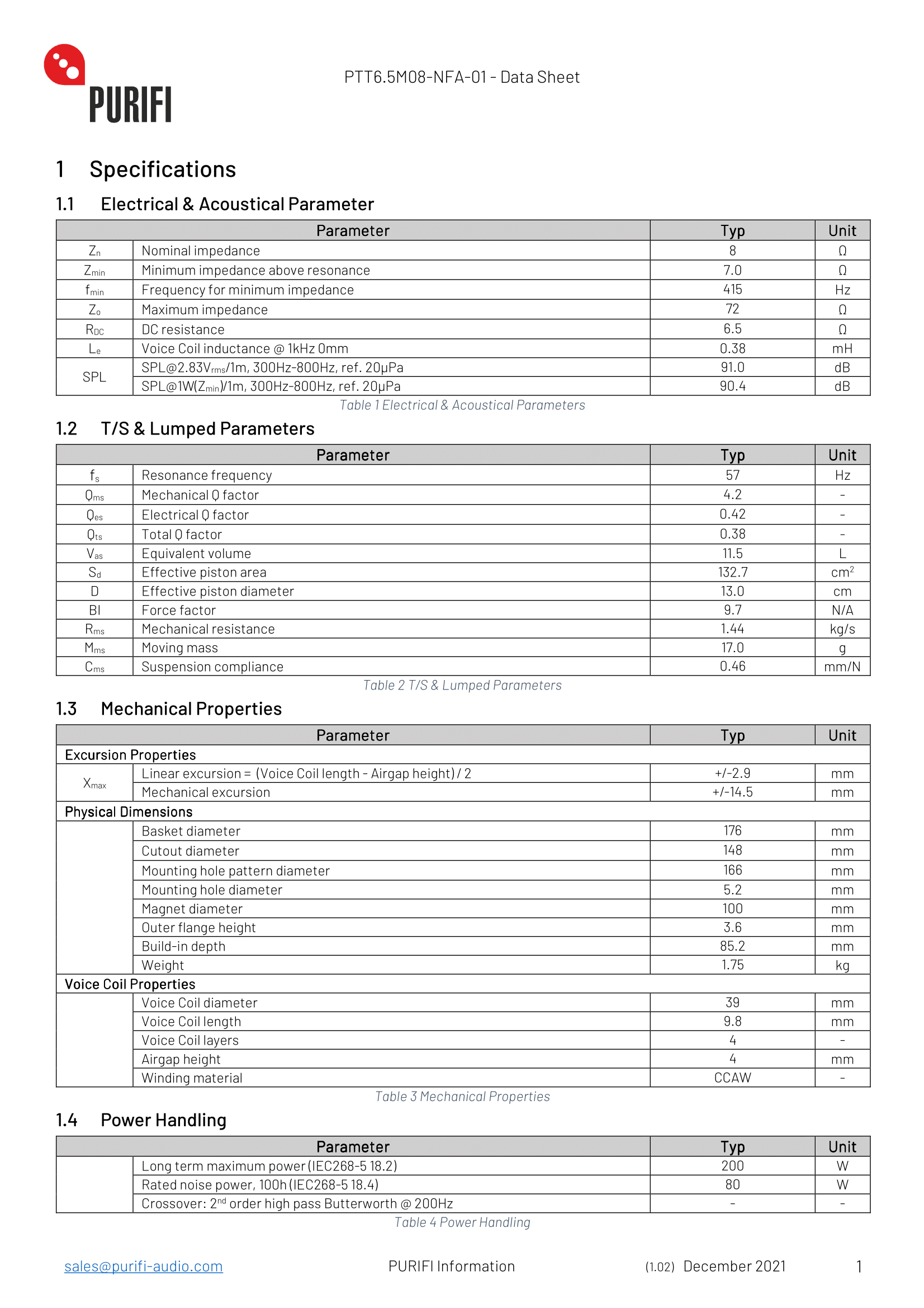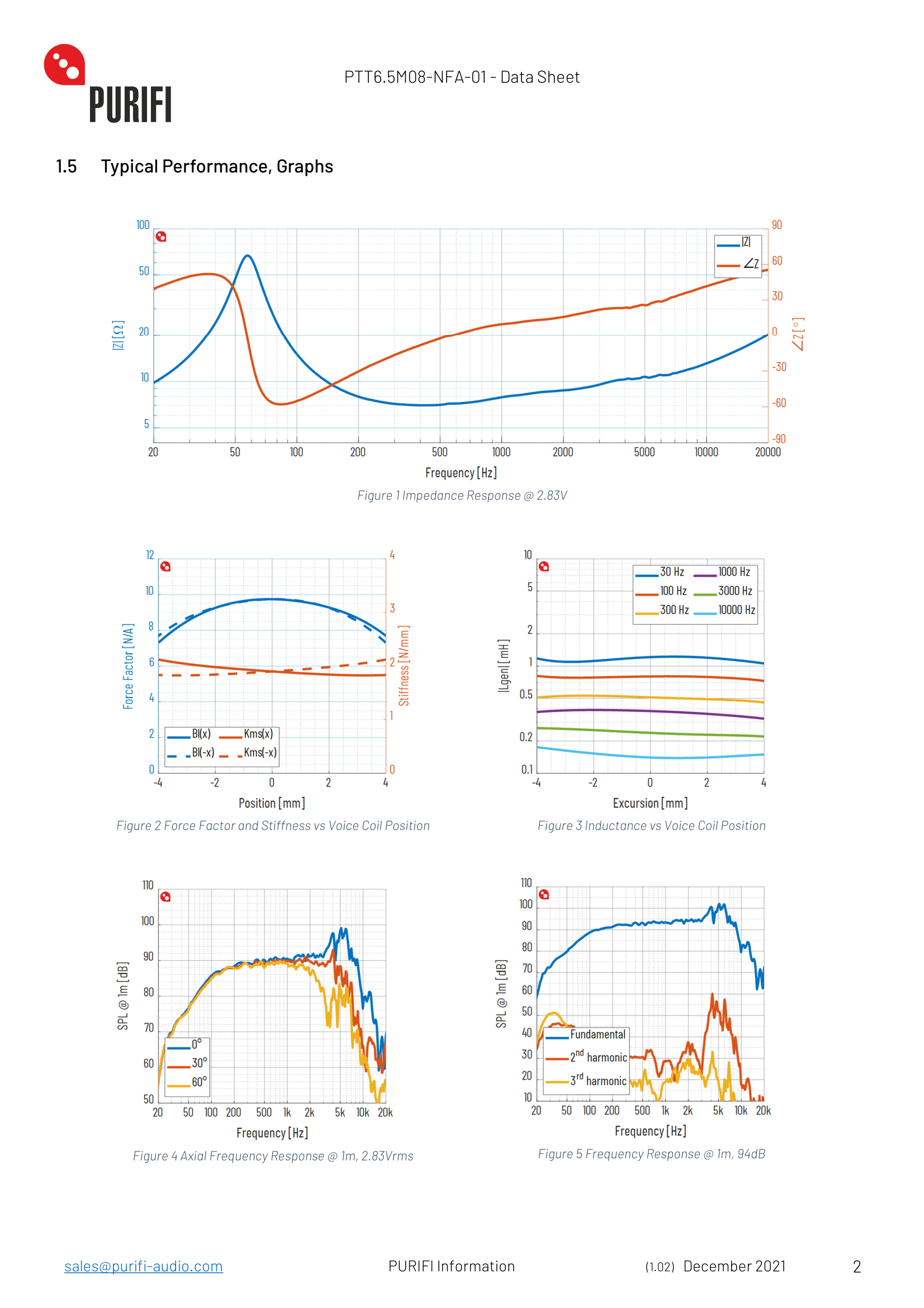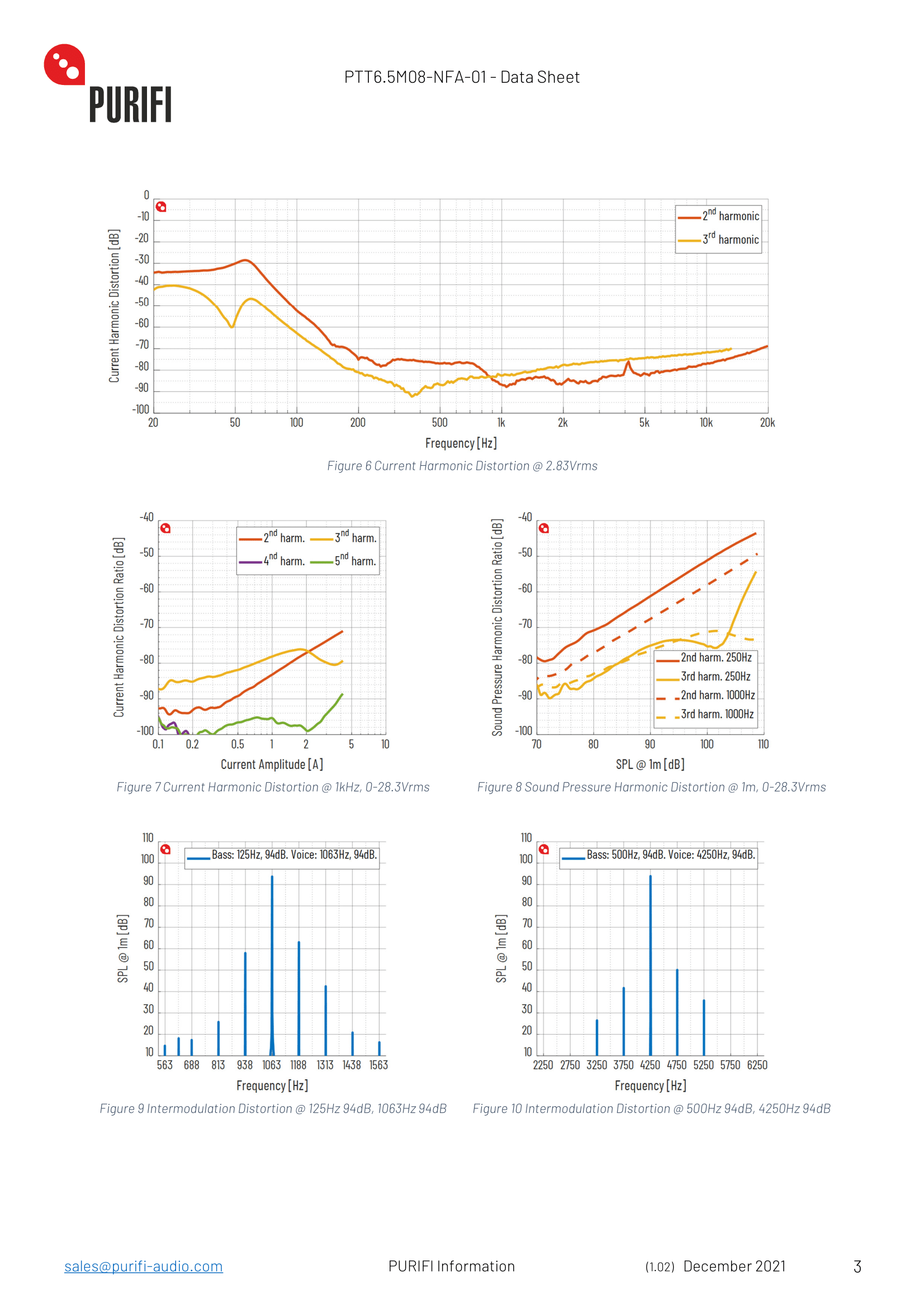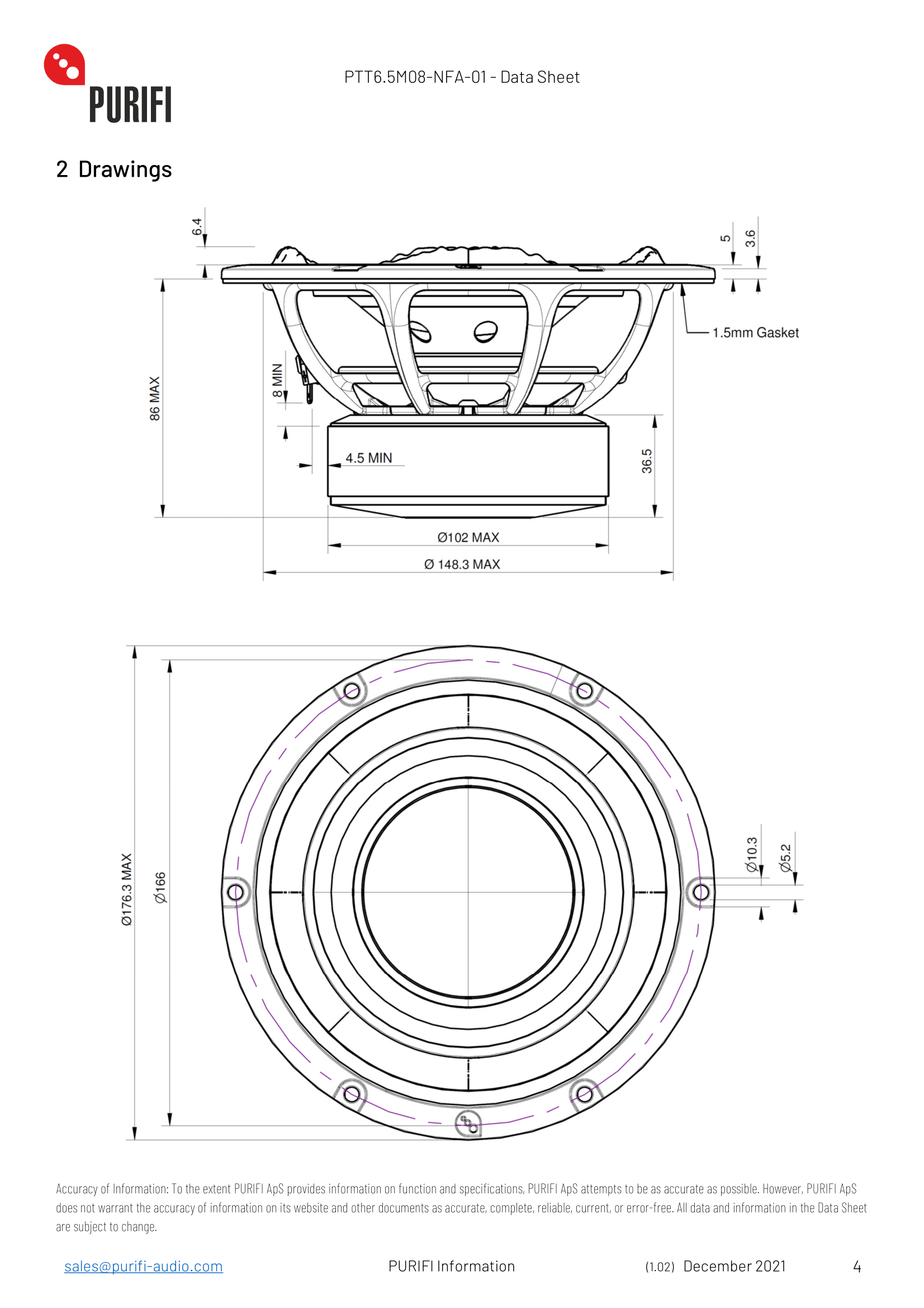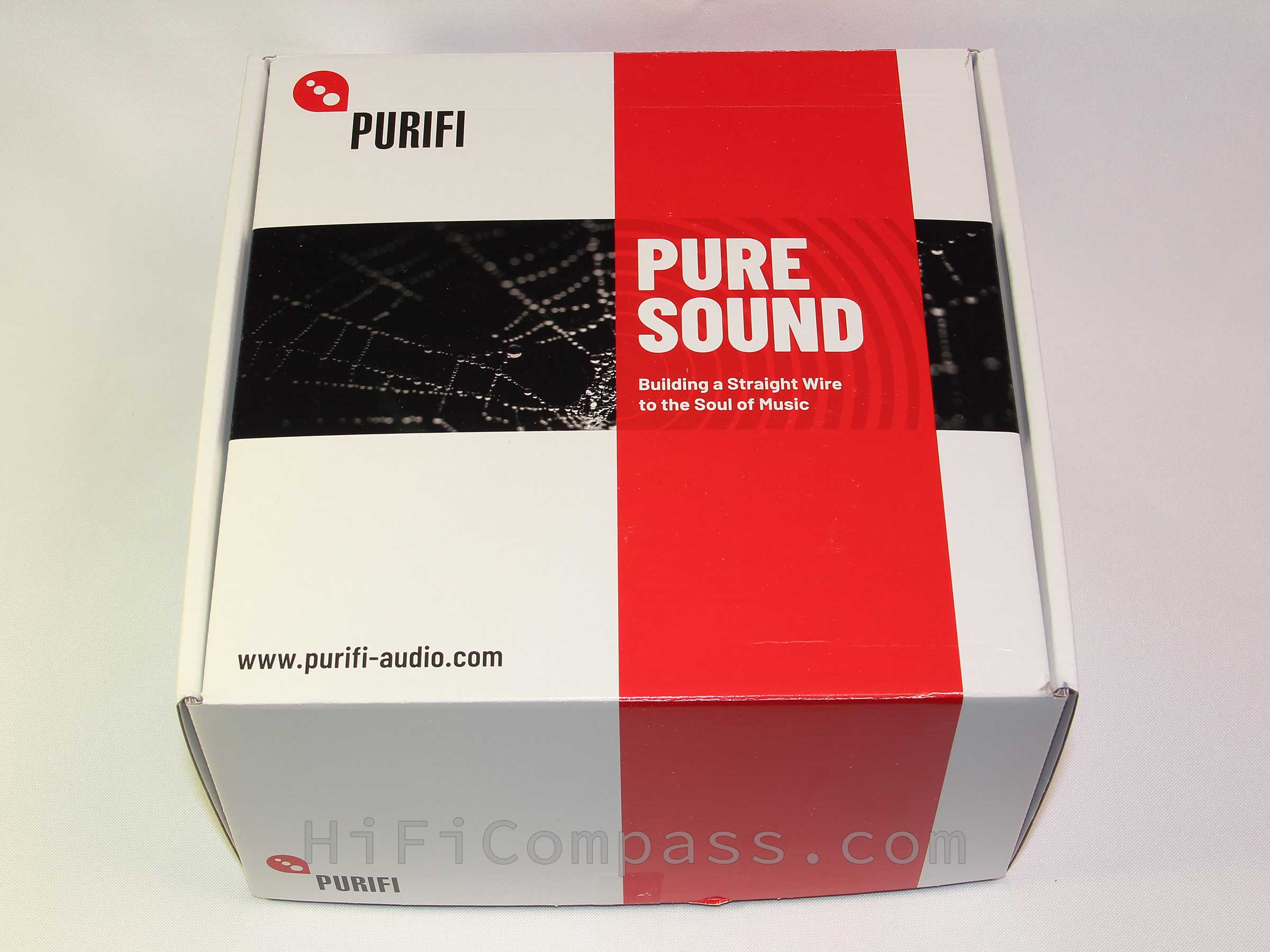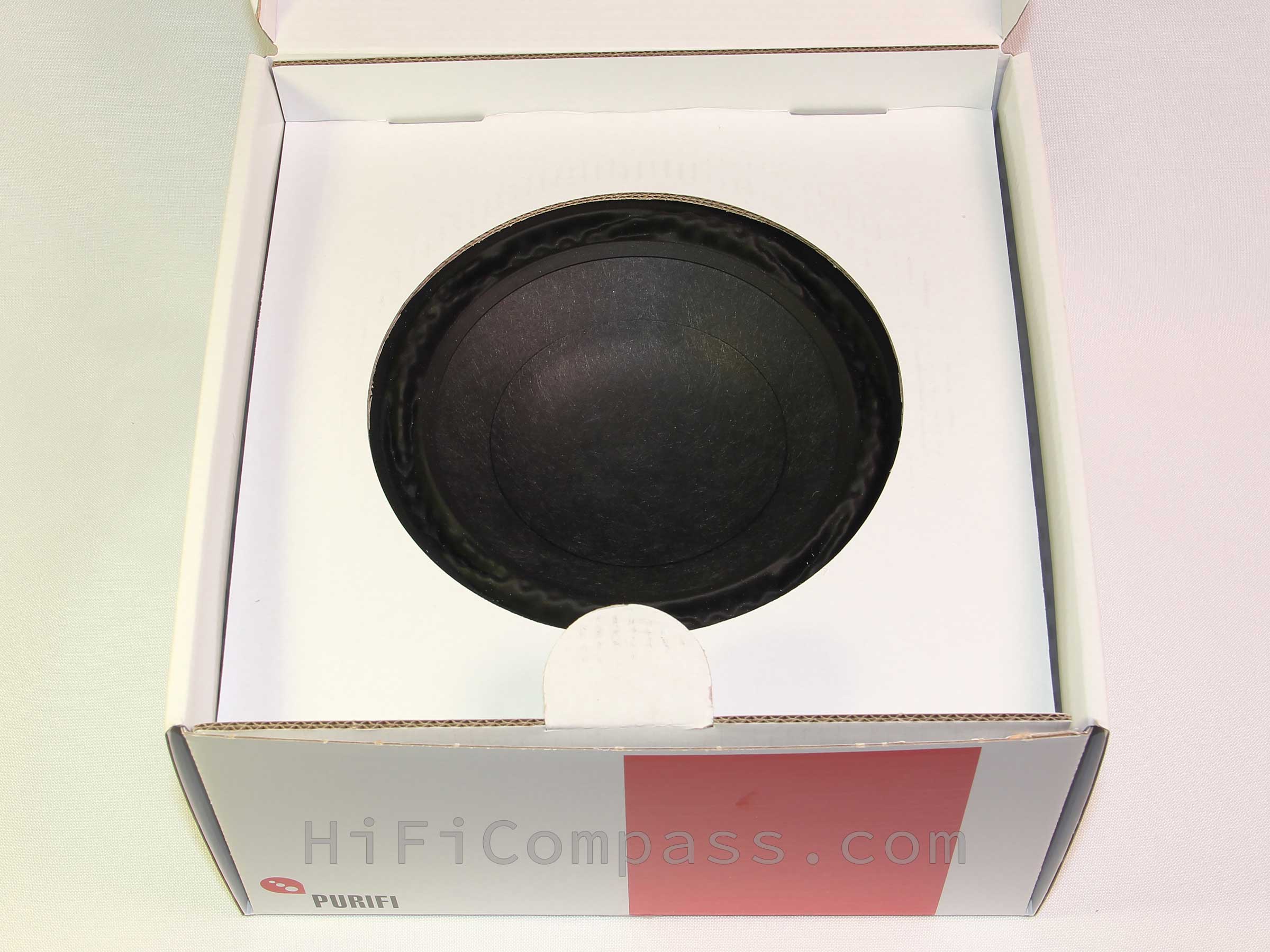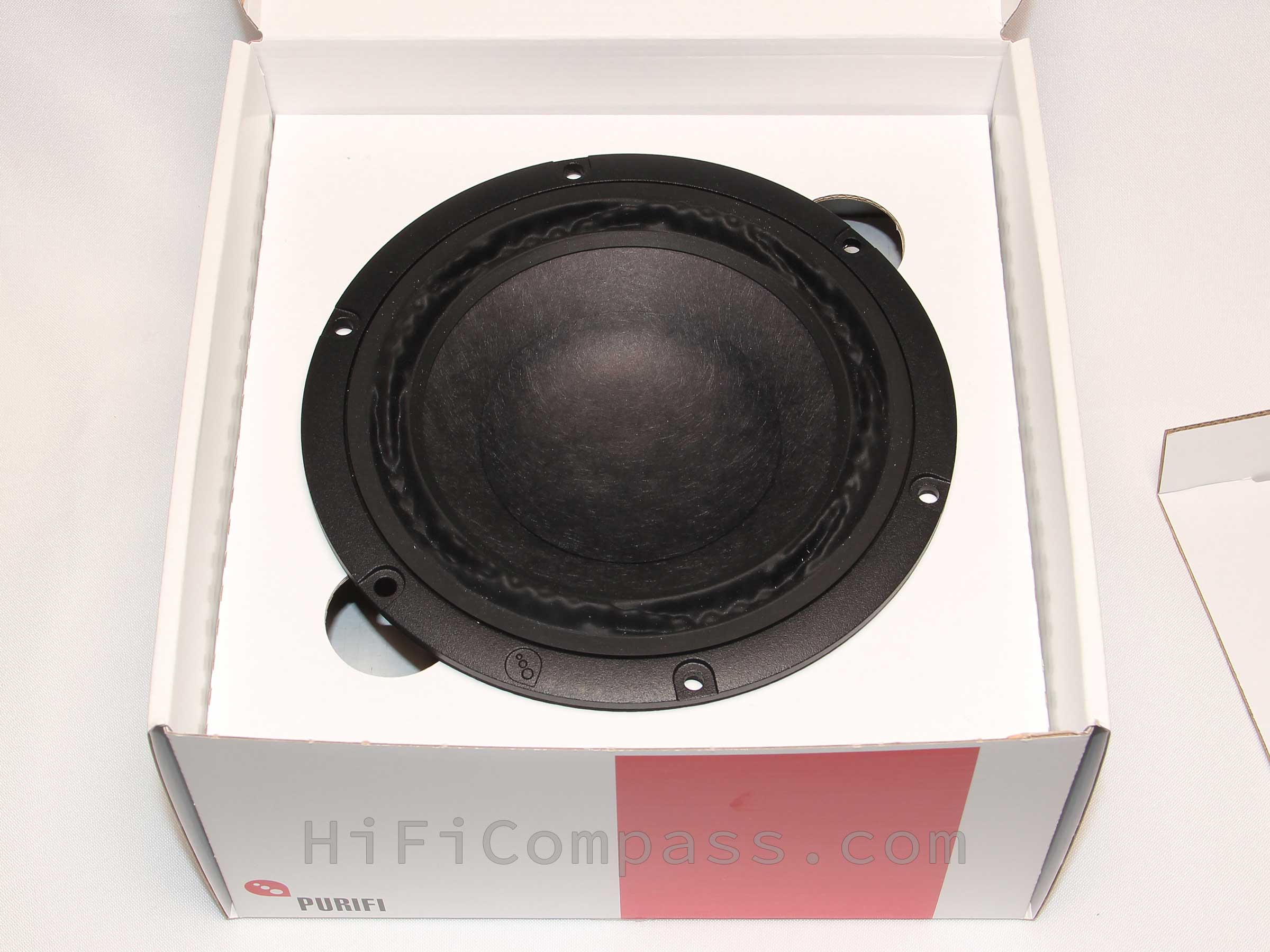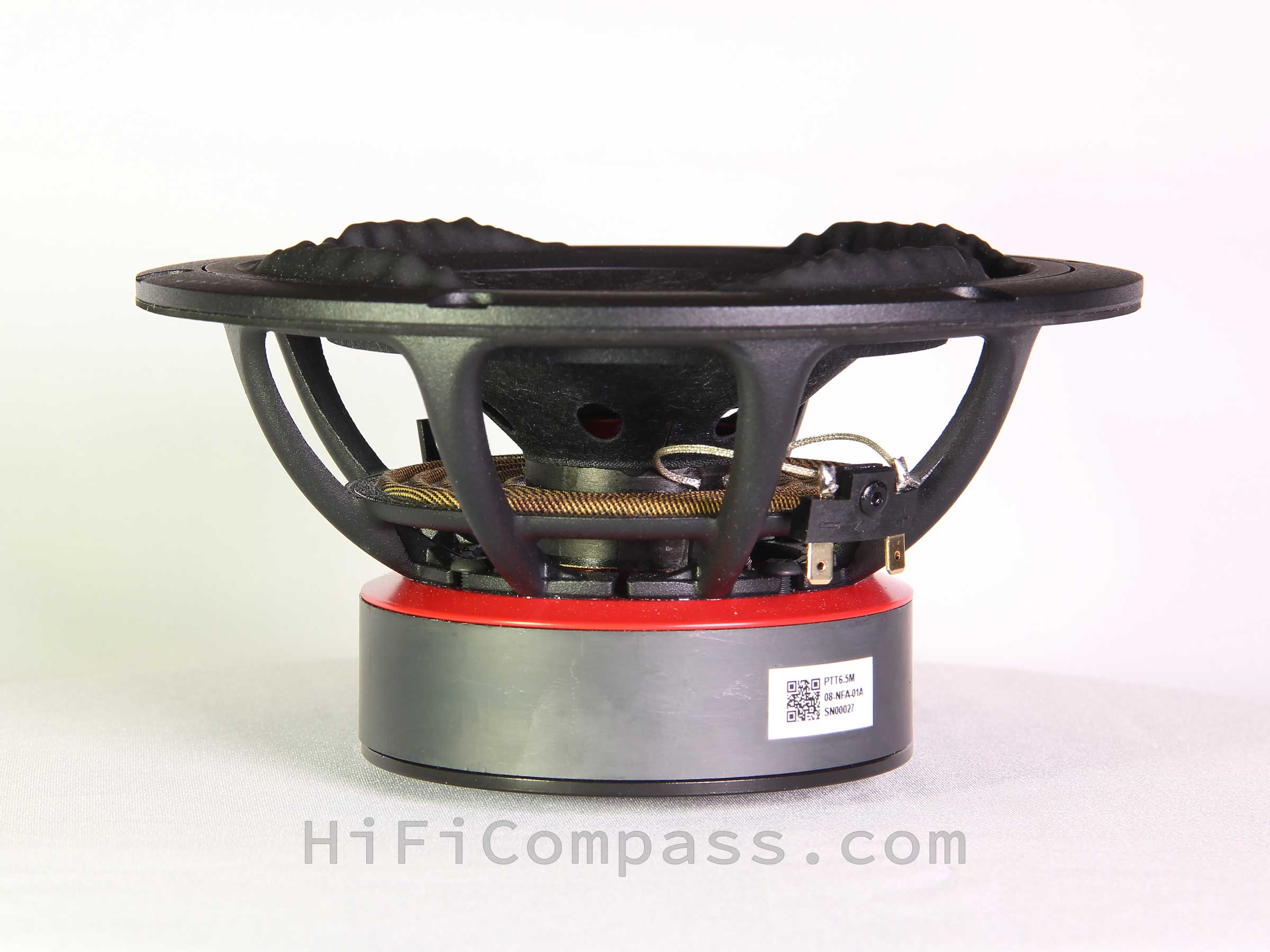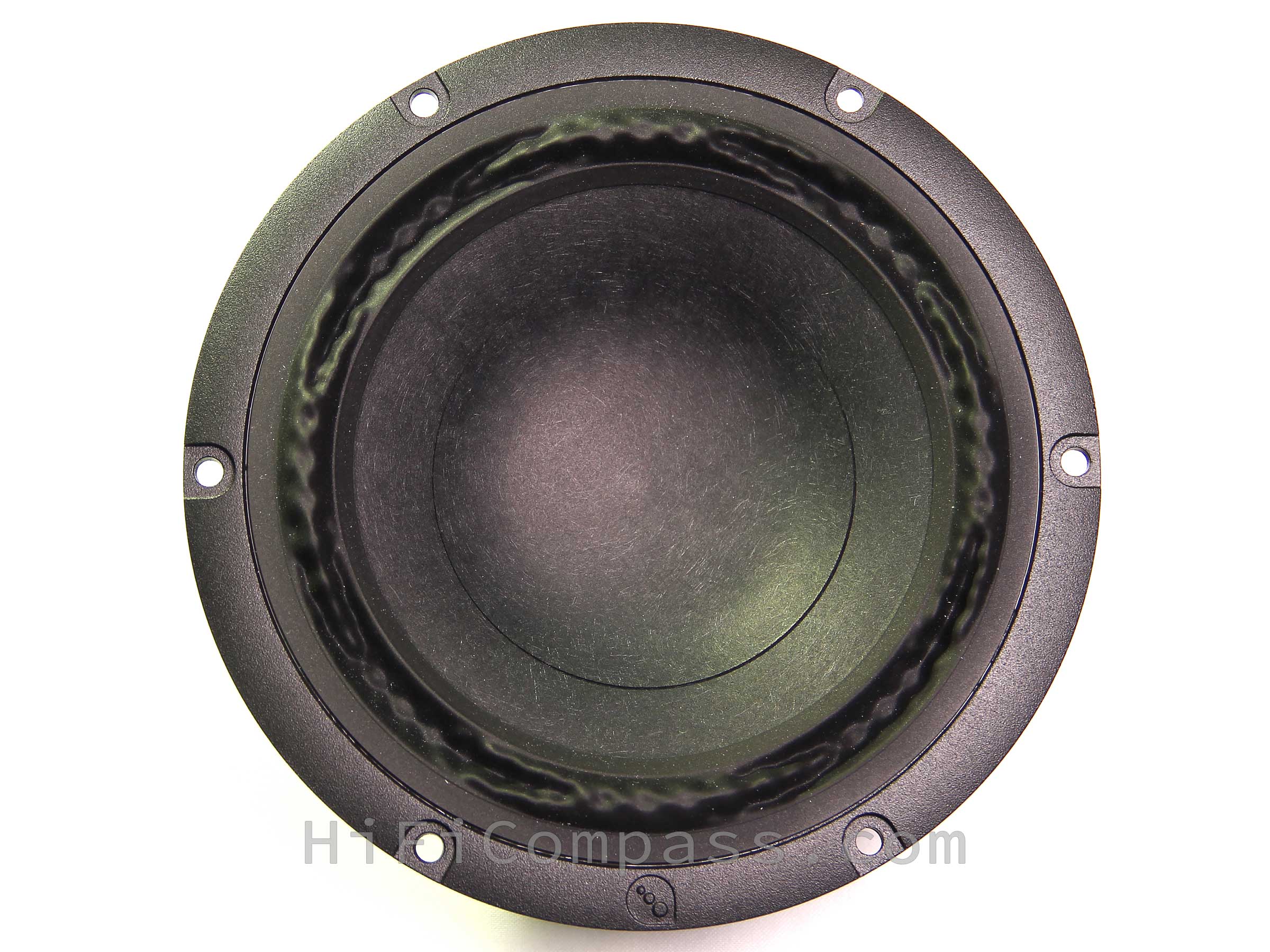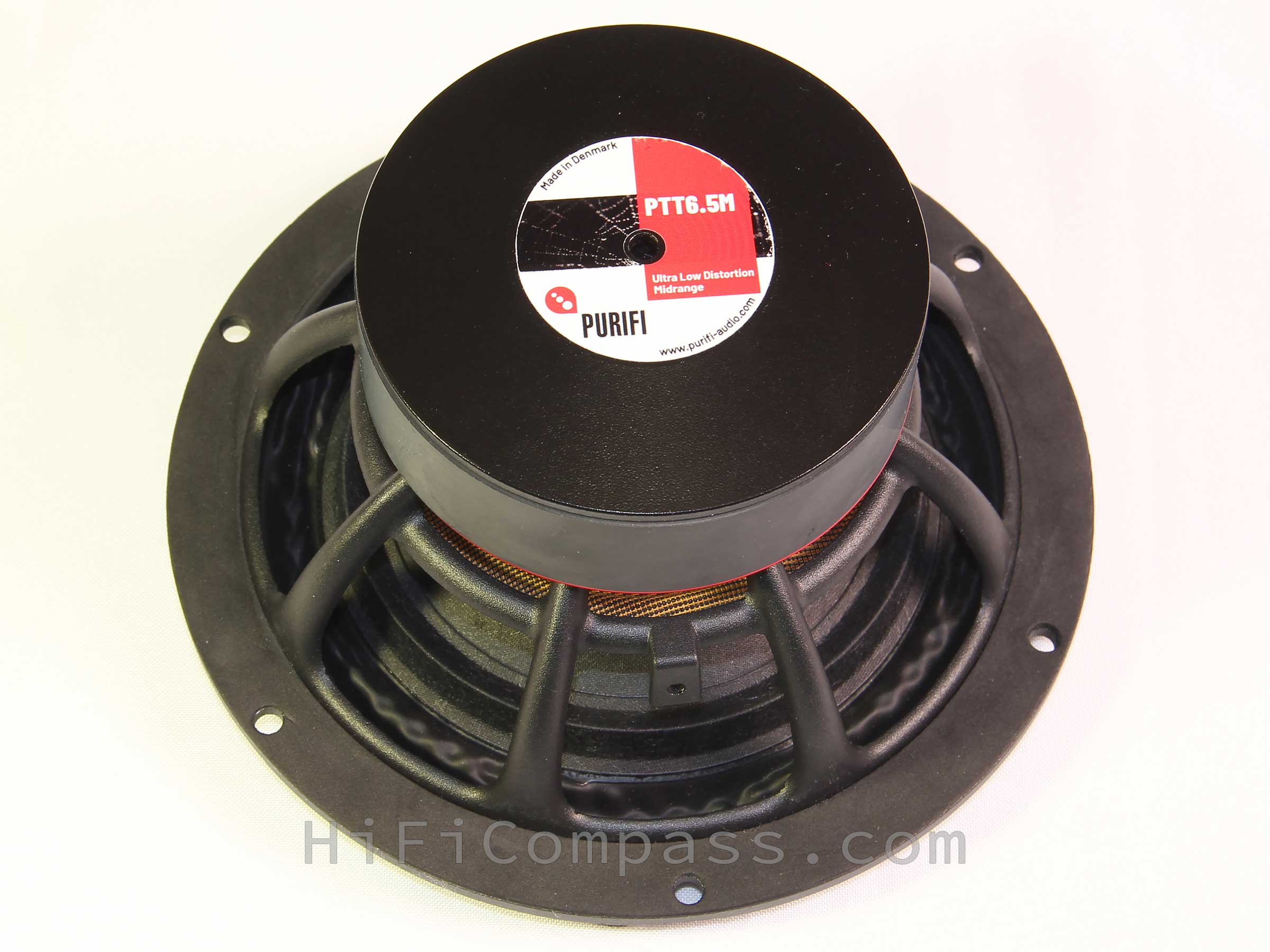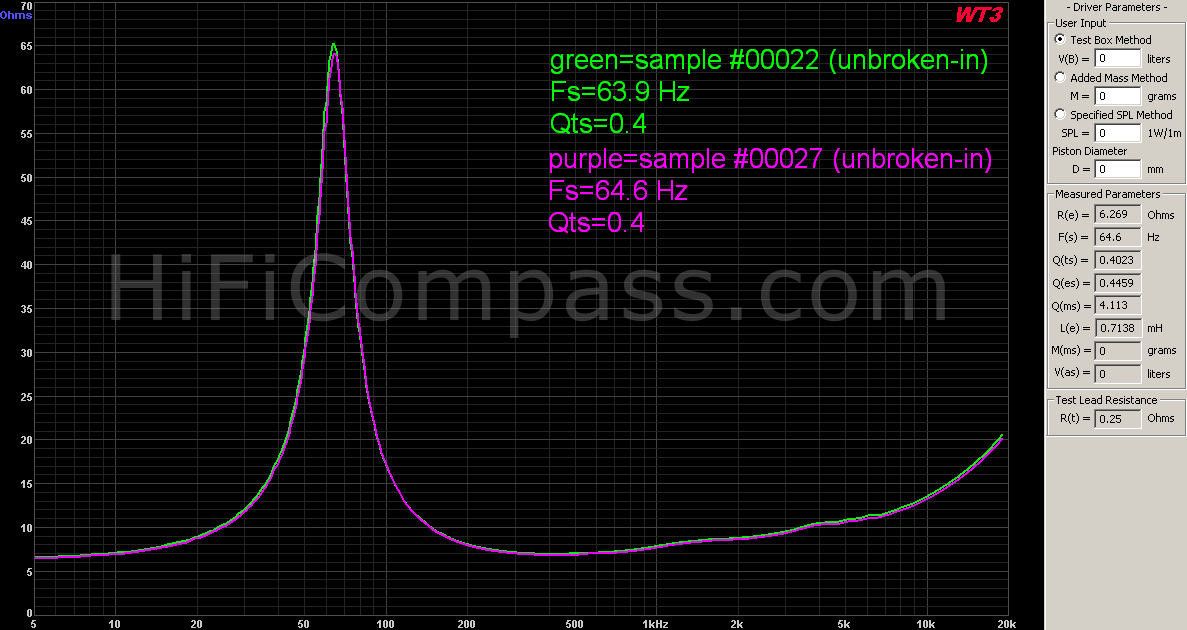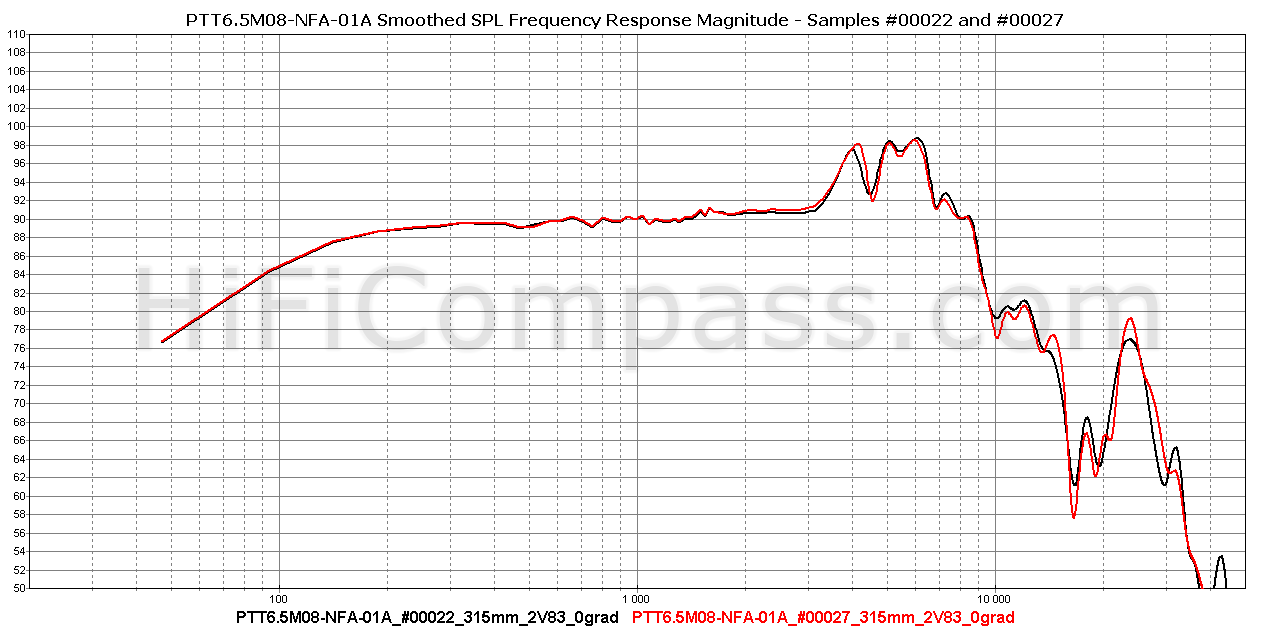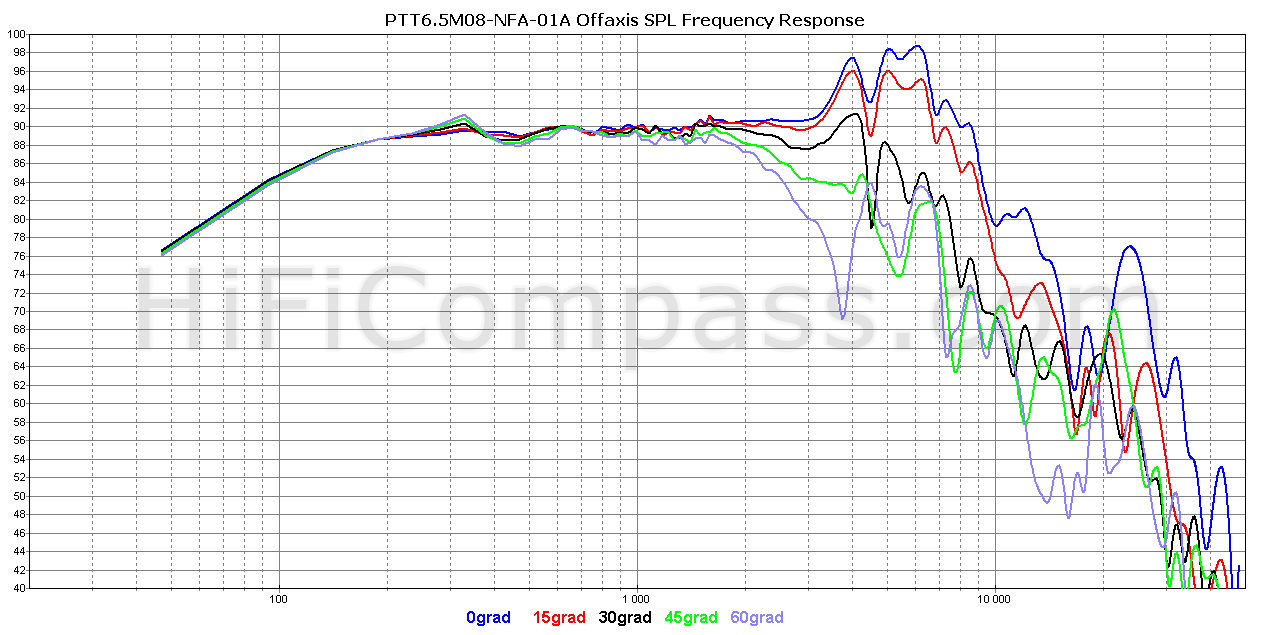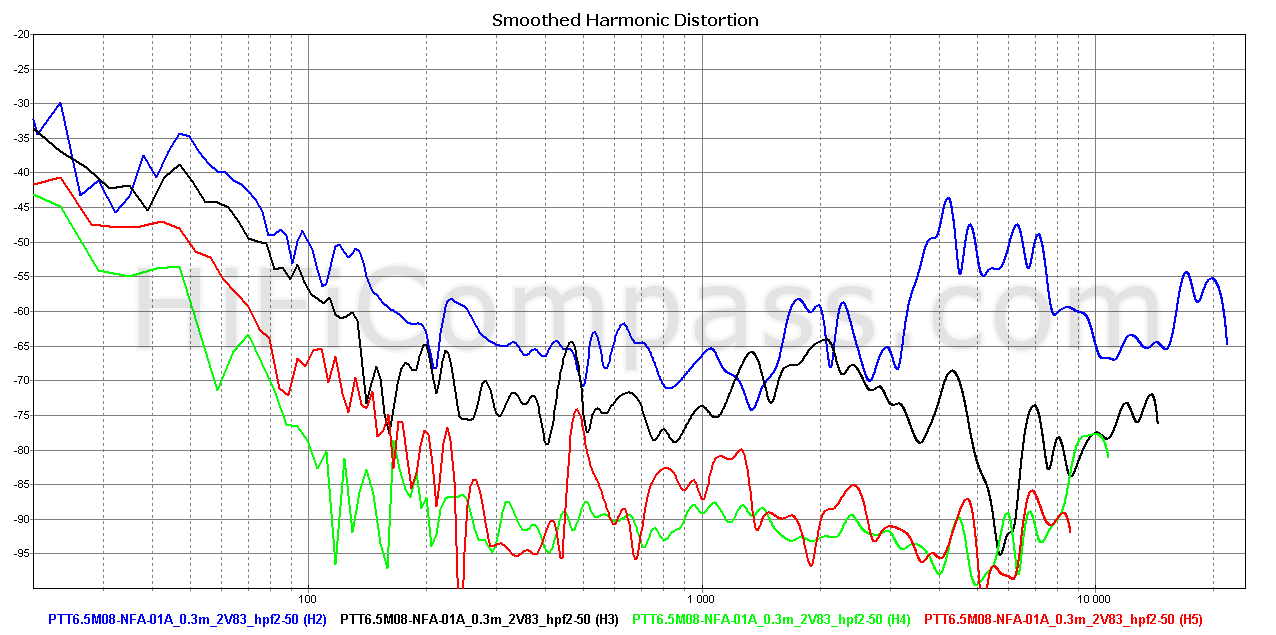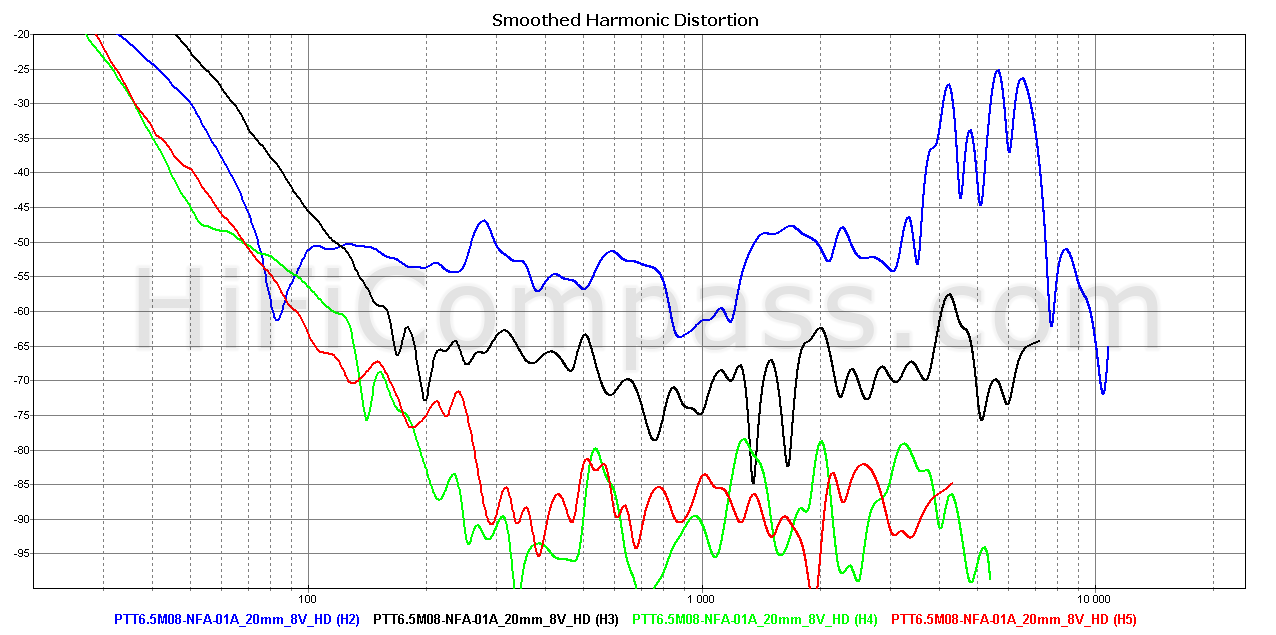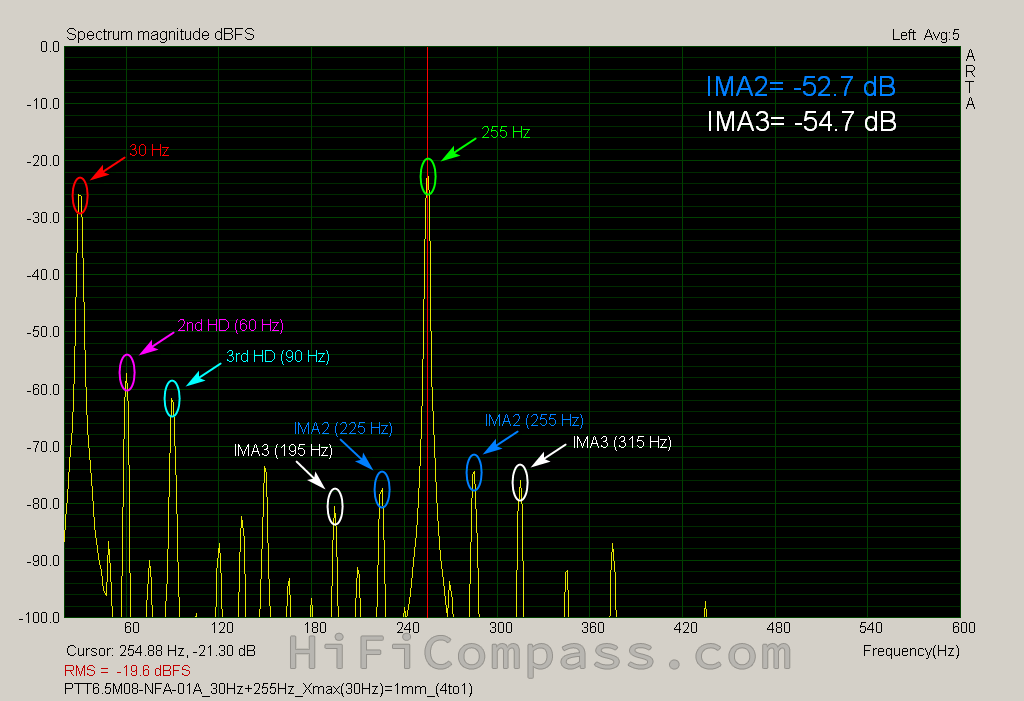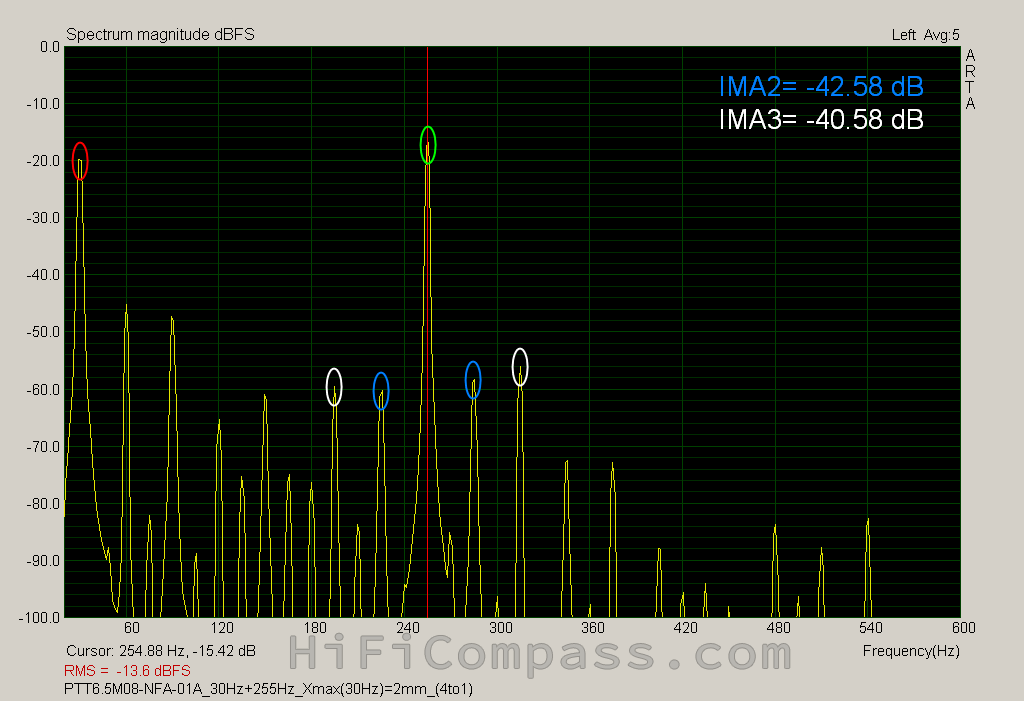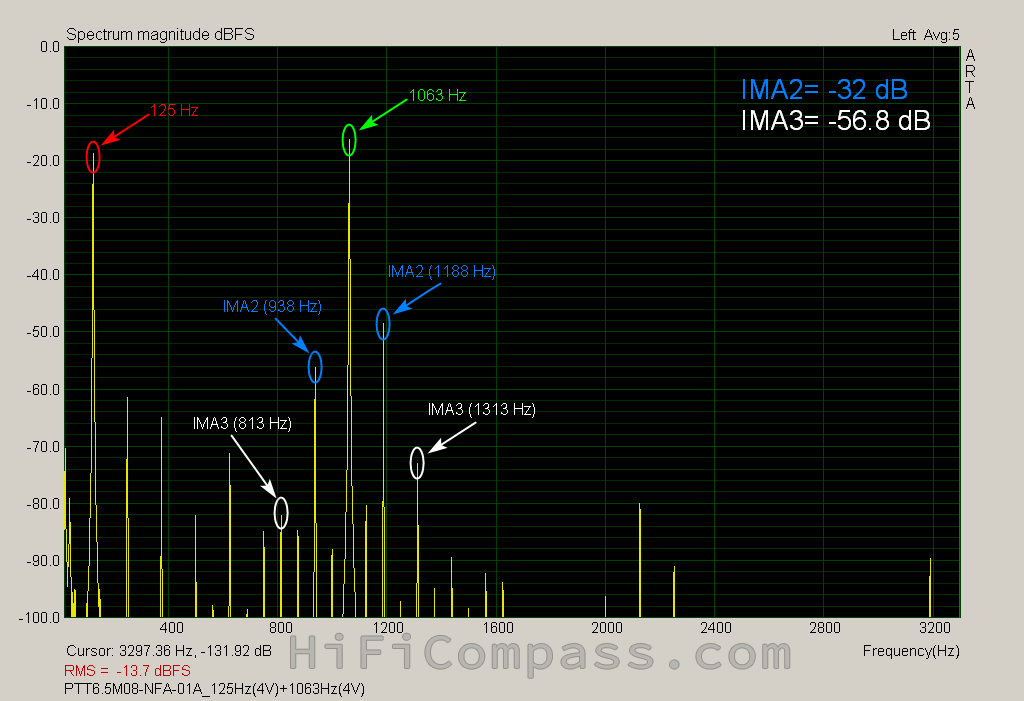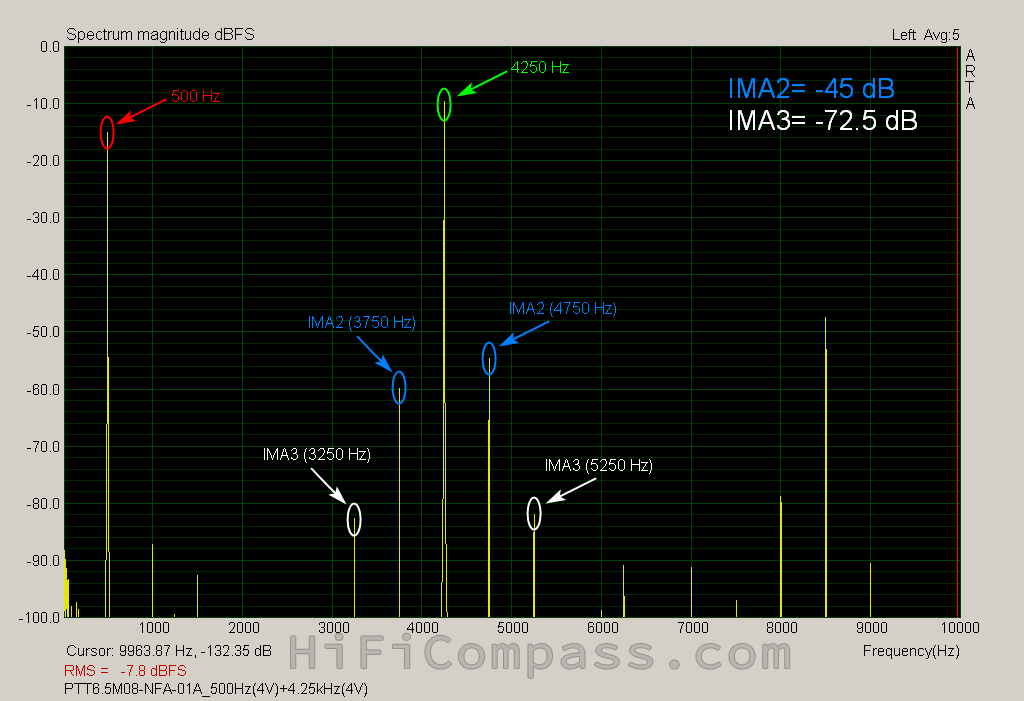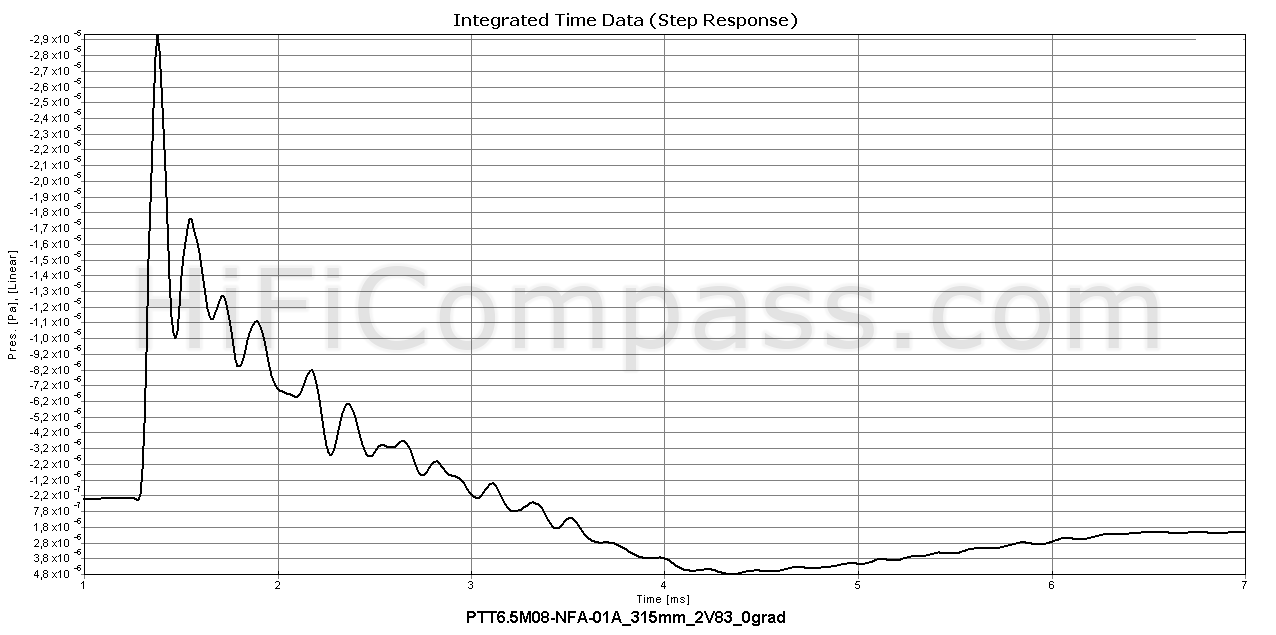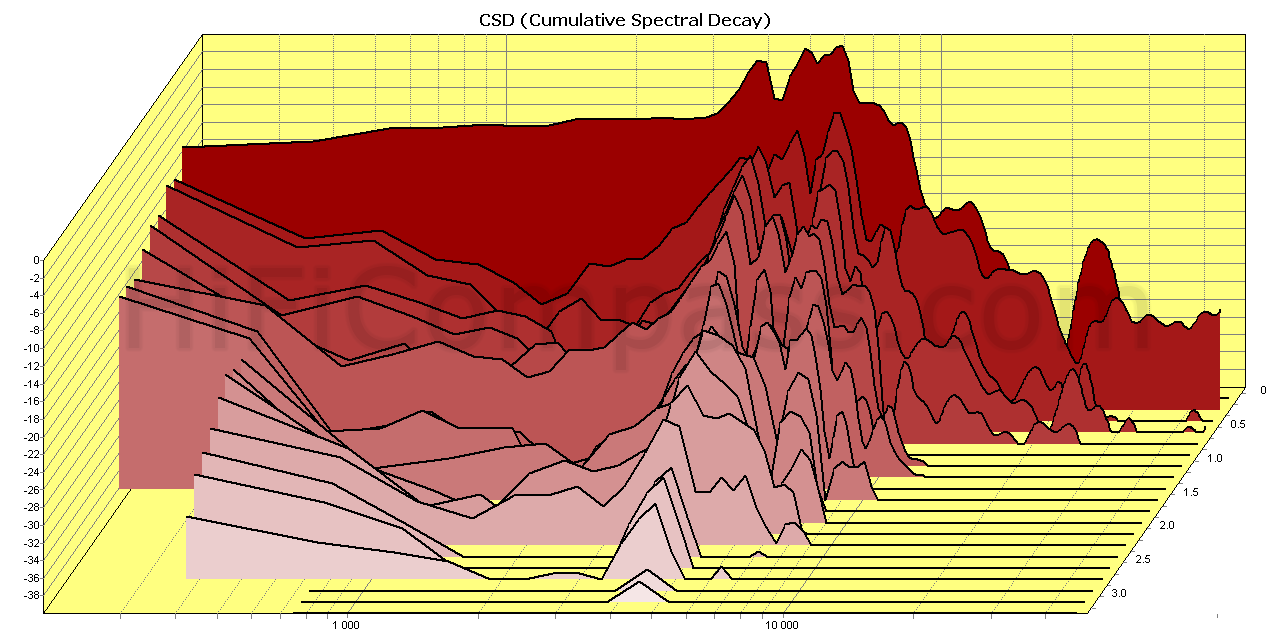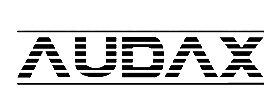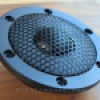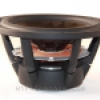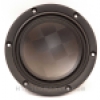HiFiCompass
Purifi PTT6.5M08-NFA-01A 6.5" true midrange
What is on the test bench?
Only six months have passed since the Danish company PURIFI announced its first 6.5" midrange speaker PTT6.5M04-NFA-01 with a paper cone. In a sense, this is a significant model, since before it the Danes made only horizontal movements and paid attention exclusively to midwoofers that have already gained huge popularity around the world. Now they take a step in vertical direction and open the door for themselves to the segment of midrange drivers.
And now, I'm holding in my hands the 8-ohm "true" midrange PTT6.5M08-NFA-01A, based on the same chassis and technologies as the long-stroke PTT6.5X04-NFA-01 midwoofer, but with adaptation of all key parameters and design features for improved midrange reproduction. It is also available in 4 ohm version.
You can read the history of the PURIFI company here.
Why do we test this?
The midrange PTT6.5M08-NFA-01A was kindly provided for testing by PURIFI, for which I would like to express my deep gratitude to it, as well as personally to its members Lars Risbo and Claus Neesgaard for time spent discussing technical aspects related to design and technical solutions applied in the speaker driver.
What did the manufacturer state?
- Dedicated Midrange Driver with Enhanced Efficiency
- Neglible Force Factor Modulation and Surround Radiation Distortion
- Ultra Low Magnetic Hysteresis Distortion
- Utilize PURIFI’s Neutral Surround Technology
- Designed and Manufactured in Denmark
PURIFI has the most detailed and informative datasheets of any company I know of. In them you can find everything you need to design loudspeakers and even more.
In addition to very familiar plots of the axial SPL frequency response and the impedance frequency response, the following have been added:
- Inductance vs Voice Coil Position
- Forse Factor and Stiffness vs Voice Coil Position
- Current Harmonic Distortion @ 1 kHz, 0-28.3 Vrms
- Sound Pressure Harmonic Distortion @ 1 m, 0-28.3 Vrms
- Intermodulation Distortion @ 125 Hz 94 dB, 1063 Hz 94 dB
- Intermodulation Distortion @ 500 Hz 94 dB, 4250 Hz 94 dB
The PTT6.5M08-NFA-01 is positioned as a true midrange speaker, in this regard, it is interesting to see how and what numerical parameters have changed compared to the long-stroke woofer PTT6.5X08-NFA-01:
- The moving mass of the PTT6.5M08 has decreased from 24.4 to 17 gram
- The voice coil inductance has decreased from 0.53 to 0.38 mH
- The sensitivity has increased from 86.9 to 91 dB/2.83 Volt*1m
- The linear excursion has decreased from 9.8 to 2.9 mm per side.
- Vas has decreased from 26.4 to 11.5 litres
- Fs has increased from 31 to 57 Hz
The linear stroke of 2.9 mm no longer allows us to classify the speaker as a woofer. The moving mass has noticeably decreased and has become commensurate with the mass of existing 6" midrange speakers for the home audio. A quick search in this segment did not give many results. In fact, the niche of specialized 6" midranges is rather scarce, so the new PURIFI model is certainly relevant and necessary:
- Accuton C173-6-090 - 14 gram
- Accuton C168-6-990 - 16.1 gram
- Morel TSCM634 - 15.3 gram
- Satori MR16P-4 - 11.2 gram
- Scan-Speak 18M/4631T - 14.2 gram
- TangBand W6-1914S - 13.97 gram
You ask, due to what it was possible to reduce the moving mass? Due to the voice coil, which has become much shorter and lighter, and due to the membrane, which has become thinner and lighter.
I can’t note any particularly outstanding parameters, but they are all very well balanced and quite sufficient for building large-scale home loudspeakers. The main thing is that the motor linearity does not fail!
Visual inspection
- Packaging - durable packaging made of harde glossy cardboard with two-color printing. Inside the box, the speaker is fixed with cardboard inserts around the basket and polyethylene foam around the magnet
- Workmanship - all at the highest level. No traces of glue, scratches, dirt or dust, spots and dents on the cone, chips on the ferrite magnet, gaps and skewness anywhere. There is nothing to complain about
- The basket - is aluminum alloy diecast with black microtextural powder coating. Acoustically very transparent. It is fixed to the magnet system by glue and four screws.
An interesting detail - the basket base, which is attached to the magnetic system, has a form not like a continuous ring, as in majority of other speakers, but has cuts between the ribs. And the thing is that the solid basket base forms a short-circuited loop, which introduces asymmetry into the magnetic field at a large voice coil stroke, therefore it was made split. Even this seemingly small detail is given attention during development -
The top and bottom flanges of the magnetic system are made of metal and painted one in black - I believe, to improve heat dissipation, and another in red for an attractive visual appearance
- The magnet is of ferrite, nothing special
- The surround is very unusual. It is made of NBR rubber and in its shape resembles alternating mountain ridges. The four ridges look outward and another fours inward. The surround is absolutely symmetrical relative to the basket flange plane. This is the principle of PURIFI Neutral Surround - it is symmetrical, unlike conventional half-roll surround, due to which the effective radiation area remains constant throughout the entire voice coil excursion. In traditional half-roll surrounds the radiation area increases during the inward voice coile movement and decreases when moving outward, introducing additional nonlinearity.
- The cone - is made of cellulose with addition of long synthetic reinforcing fibers. The dust cap is concave and made of the same material as the cone. The material is very tightly pressed and when tapped with a finger gives an echo, indicating a high stiffness of the membrane. The cone profile has a barely noticeable curvature, one can say almost straightforward. On the neck side the cone has some holes for ventilation the space under the dust cap
Another unusual detail is a L-shaped rib of the same material as the cone, glued along the entire circumference of the back of the cone. This element increases the cone edge stiffness and helps to solve the eternal problem of surround-edge-of-cone resonance - The lead wires are silver plated
- The terminal block looks worthy and matches the status of the speaker. It is made of thermosetting plastic with gold-plated knife terminals molded into it
- The spider is made of BIMAX material. BIMAX is featured by its durability and increased resistance to mechanical stress. As a rule, it is used in top models of speaker drivers
- The voice coil former - is made of fiberglass. It is also a very popular non-conductive material, which allows to avoid additional losses from eddy currents, as in the case of aluminum formers, and to maintain high mechanical quality factor of the moving system. The former doesn't have ventilation holes.
- The voice coil is much shorter compared with the long-stroker PTT6.5X08-NFA-01 and only protrudes slightly from the magnetic gap. The coil is four-layered and wound with copper clad aluminum wire (CCAW) with variable pitch, which is one of the secrets of obtaining high linearity of BL(x) and Le(x) over the entire excursion range.
The midrange PTT6.5M08-NFA-01 got an updated basket, which the company has now brought to perfection. Here's what's been upgraded:
- The new basket has become noticeably more massive, they didn't spare the material anymore, and much more inert compared to the previous version, which seemed flimsy to me. Now all the critical elements have become thicker and stiffer, and the mounting flange has got rid of the “stingy” cavities on the back side and has become solid in cross section. A very correct decision!
- The foam rubber gasket is glued to the back of the basket at the factory - a trifle, but nice, because you don’t have to do it yourself.
-
The terminal block is attached to the bracket, which in the new basket has changed its angle in such a way that the attachment to the terminals has become much more convenient and the magnet now does not interfere.
-
The ring platform for the spider has become a few millimeters lower, that is, further from the basket flange. Due to this, the attachment point of the surround and the spider became further apart, which contributes to a more stable position of the voice coil in the gap and reduces the “rocking” of the moving system. In addition, a few millimeters freed under the neck of the cone made it possible to change the point of attachment of the lead wires from the cone to the voice coil former, which I consider more reliable and correct.
All subsequent speaker models will now be equipped with a new basket. This circumstance must be taken into account when designing loudspeaker enclosures, since the minimum opening for the new basket has increased from 145 mm to 148.3 mm.
So, we see an excellent top-class design, already well known from previous reviews, but with a significantly improved basket.
Impedance frequency response
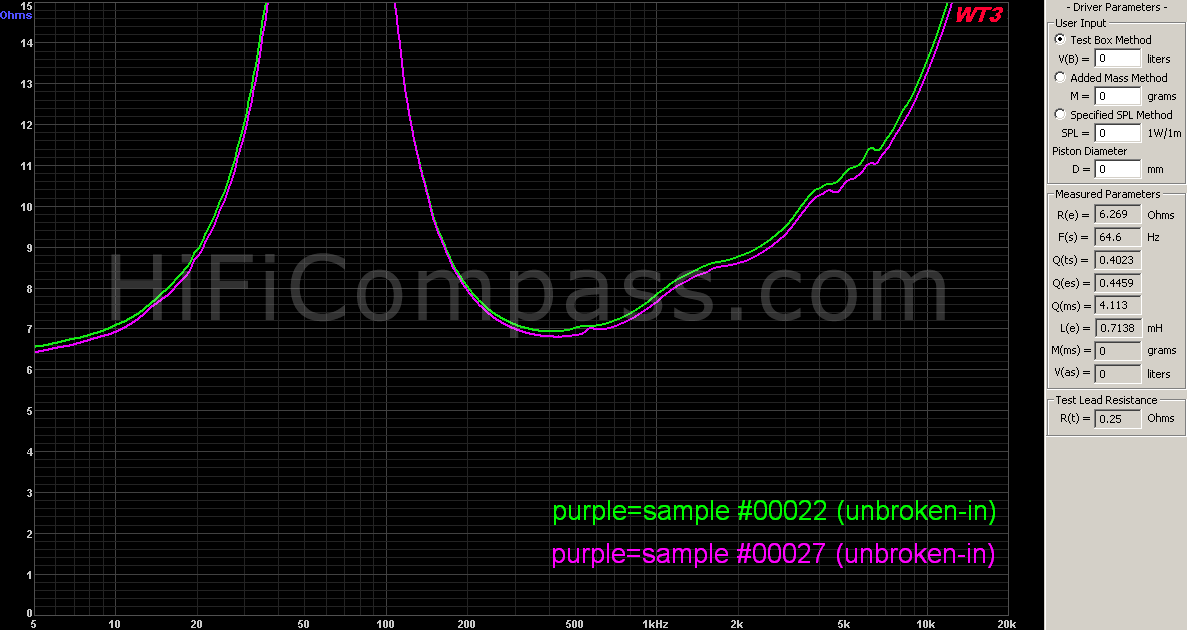
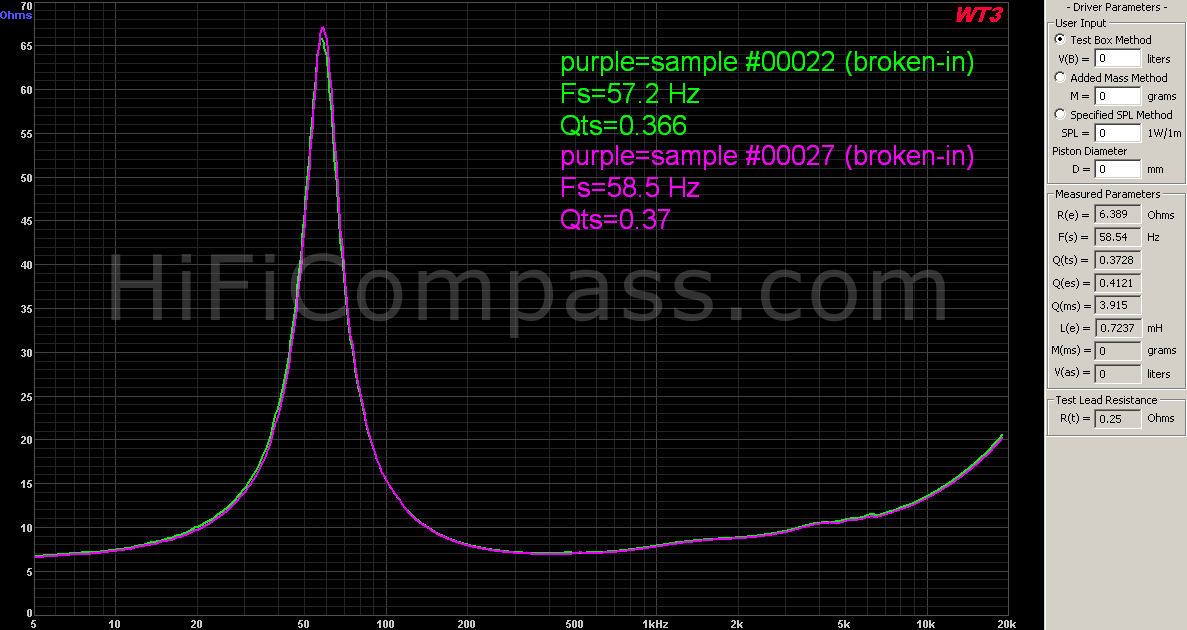
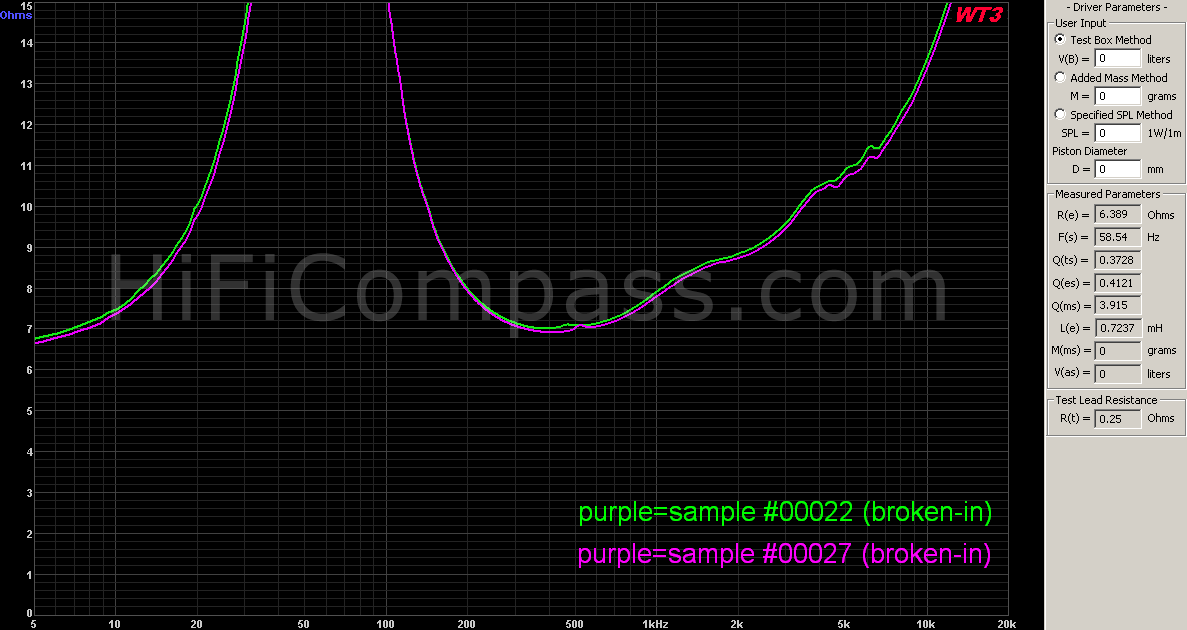 The plots above show at different scales the impedance curves for two samples of the PTT6.5M08-NFA-01 before and after broken-in.
The plots above show at different scales the impedance curves for two samples of the PTT6.5M08-NFA-01 before and after broken-in.
Taking into account the error of existing methods for measuring speaker parameters, as well as their dependence on numerous factors (temperature, humidity, the degree of the broken-in, the test voltage level), I believe that the results obtained are in excellent agreement with the datasheet. The consistancy of parameters and characteristics between two samples is also commendable.
Comparing the midrange's impedance to that of the PTT6.5X08-NFA-01 8 ohm midwoofer, it's easy to see how the lower inductance of the shorter voice coil results in a reduction in impedance from 34 to 20 ohms at 20 kHz. The new, lighter and thinner membrane can't longer boast such a rigid character as the midwoofer cone has, which is noticeable by the slight ripples on the impedance curve. For any lightweight paper membranes such a behavior is unavoidable, but in this case it is quite well controlled.
In the region of 500 Hz both samples have a small irregularity. Initially, I blamed the lead wires for this, however, after a thorough check, these suspicions were completely removed and assigned to the spider. I would venture to suggest that it was its own resonance that was imprinted on the impedance. If it does not entail any more consequences, then it can be ignored.
The impedance frequency response is a visiting card of a speaker driver and says a lot. In this case, about a moving system with low losses (high Qms) and a well balanced cone (slight ripple in the impedance curve) driven by a good motor (low voice coil inductance).
On-axis frequency response
The frequency response of both samples are identical to each other. The measured sensitivity in the range from 300 Hz to 800 Hz averaged 89.5-90 dB, which is 1-1.5 dB lower than the declared value of 91 dB.
In the range up to 3 kHz the frequency response is very even and smooth. The unevenness in the 300 Hz - 3 kHz range does not exceed +/-1 dB - excellent!
In the 1 - 2 kHz region there are no any signs of nasty surround/membrane resonance, which is a typical problem for soft cones. This is very rarely can be seen in paper cone speakers from other manufacturers. The L-shaped rib on the back side of the cone does the job just fine.
Starting from 3 kHz, the paper membrane begins to "break" and goes from the piston to the zonal mode, which is accompanied by resonant bursts of frequency response up to 8 dB in the range of 3.1 - 6.8 kHz. The nature of the "break-up" mode, namely the sharp rise and fall of the frequency response at the first membrane resonance, allows us to speak of a rigid membrane with little damping (another typical example is the SB17NRX2C35-4). The frequency response of softer and heavily damped membranes smoothly overcomes the first "break-up" resonance - W18NX003, 8945P, WF182BD03, 18W/8542, or even barely shows its signs - 18WE/4542T00, 18H521706SD-4, 18M/4631T00.
Comparing the PTT6.5M08-NFA-01 with the PTT6.5X08-NFA-01 midwoofer, we can note a noticeable extention of the midrange's frequency response towards high frequencies. Its level at 8.5 kHz is still the same as at 1 kHz, while the midwoofer's frequency response here already drops by 12 dB. This much-needed extension contributes to more open and transparent midrange reproduction, and also allows for a shallower acoustic roll-off when mated to a tweeter.
Off-axis frequency responses (315 mm)
Harmonic distortion (315 mm)
Above are the plots of harmonic distortion at average sound pressure levels of 90 and 105 dB. Here we analyze the frequency range from 200-300 Hz and above. To limit the speaker overload in terms of power and membrane displacement amplitude when measuring harmonic distortion, a 2nd order digital high-pass filter with cutoff frequencies of 50 Hz (at 2.83 Volt) and 80 Hz (at 16 Volts) was used. For the frequencies below 200 Hz much more accurate data can be obtained from near-field measurements (at a distance of 5-20 mm).
Despite the seemingly not too impressive linear stroke of 2.9 mm, the midrange driver feels great even at a frequency of 150 Hz at a sound pressure of 105 dB.
It's nice to see that the second harmonic dominates the entire range. The nature of the distortion is stable regardless of the sound pressure level. The membrane does not lose its rigidity and does not "break" anywhere, which is usually accompanied by sharp bursts of distortion. An unusual situation for me - there is nothing to complain about at all. But wait, I found something. In the region of 500 Hz at a voltage of 2.83 Volt we see bursts of the 3rd and 5th harmonics. Most likely, this is how that small impedance hump manifested itself. The bursts are non-critical, narrow-band and do not worsen at all when the voltage rises to 16 Volts, but on the contrary, they even dissolve in the general "harmonic" background.
The harmonic distortion measurements also confirmed the values given in the datasheet.
I don't want to say any more... I want to stare silently for a long time and enjoy the lowest distortion of a 6.5" midrange I've ever seen. Bravo!
Harmonic distortion (5mm - 20 mm)
As the frequency decreases, all harmonics begin to grow and the third one gets dominating. Frequencies below 100 Hz are clearly outside the potential operating range of the midrange driver, however, even here the distortion is small and can give odds to some top midwoofers like VIFA NE180W-04 (linear stroke 5 mm), SATORI MW16P-4 (linear stroke 6 mm) , Morel SCW636 (linear stroke 5 mm).
The overall level of harmonics, as for a "true" 6.5" midrange, can be rated as "very low".
Voice coil current harmonic distortion


This type of measurement, despite its simplicity, is an excellent tool for assessing the linearity of a speaker motor. The above plots show the frequency dependences of the 2nd, 3rd, 4th and 5th harmonics of the voice coil current at 2 and 5.6 volt. To limit the speaker overload in terms of the membrane displacement when measuring harmonic distortion, a second-order Butterworth type high-pass filter with a cutoff frequency of 50 Hz was used.
Voice coil current nonlinearity is the direct nonlinearity of the mechanical force driving the speaker cone, since this force is related to the current by a simple relationship F=B*L*I, where B is the magnetic field strength, L is the length of the voice coil wire inside the magnetic gap and I is the current. So, in principle, it is practically impossible to obtain sound pressure distortion lower than current distortion in the frequency range where the contribution of the motional nonlinearity becomes insignificant.
Although the level of current distortion, mainly due to the second harmonic, turned out to be higher compared to the long-stroke PTT6.5X08-NFA-01 midwoofer, I have no hesitation in rating the level of current distortion as "very low".
The intermodulation distortion measurement is one of way of analyzing device non-linearity. It is not an alternative, but an additional method and allows you to identify the spectral components of the inharmonious structure, which are much more harmful for high-quality sound reproduction and to which our hearing is more sensitive
There is a very good article of Bruno Putzeys - "Distortion, The Sound That Dare Not Speak Its Name", in which he very well describes the mechanism of the intermodulation distortion occurrence in a midwoofer, at second, an one interesting experiment that everyone can do. Its essence is the simultaneous supply of a musical signal to a midwoofer with a singing rather than speech (for better audibility of the effect), male or female vocals, or a violin, clarinet, flute, and sine signal with frequency of 30 Hz, the level of which can be adjusted. The sine signal causes a large cone excursion, which leads to the appearance of non-linearity of the suspension and the force factor. The suspension nonlinearity leads only to the appearance of harmonic distortions of the 30 Hz sine signal and does not affect the reproduction of midrange, while the modulation of the force factor leads to a change in the sensitivity of the speaker for midrange frequencies. This changing is manifested in the amplitude modulation of the voice notes with 30 Hz sine. Do such an experiment yourself and you will be very surprised at how much intermodulation distortion is heard and how they grow with an increase in the low-frequency component. Perhaps this will be a great discovery for you.
For testing I chose the frequencies with ratio (1:8.5). In this case the Doppler distortion is not yet dominant and the contribution of amplitude modulation can still be observed. The fractional coefficient eliminates the superposition of harmonic and intermodulation components on each other:
- 30 Hz and 255 Hz
The same frequencies were used to test midwoofers. While this is an unlikely scenario for a dedicated midrange driver, it is nonetheless of academic interest. The measurements were carried out at various cone displacement amplitudes at a frequency of 30 Hz.
The plots above show the spectra of intermodulation distortion for cone displacement amplitudes of 1mm and 2mm.
However, in these plots products of the motor nonlinearity are mixed with products of inevitable frequency modulation due to the Doppler effect. How to determine who is who? We can analytically estimate the level of the first pair of the side Doppler components using the following formula [http://www.linkwitzlab.com/frontiers.htm#J]:
For 2 mm = -42.58 dB - intermodulation is already starting to slightly exceed the Doppler threshold
- 125 Hz and 1063 Hz
These frequencies correspond to a quite real and most difficult mode of operation of the midrange speaker in terms of intermodulation distortion. 125 Hz signal stimulates maximum cone amplitude
A voltage with a frequency of 125 Hz and a level of 4 Volts creates oscillations of the PTT6.5M08-NFA-01 cone with an amplitude of about 0.6 mm, which results in Doppler components of about -44.7 dB at a frequency of 1063 Hz. We see that for this mode, amplitude modulation (IMA2=-32 dB) dominates over frequency modulation.
- 500 Hz and 4250 Hz
Another pair of frequencies that fit into the potentially possible operating frequency range
A voltage with a frequency of 500 Hz and a level of 4 Volts creates oscillations of the PTT6.5M08-NFA-01 cone with an amplitude of about 0.051 mm, which results in Doppler components of about -53.9 dB at a frequency of 4250 Hz. For this mode amplitude modulation (IMA2=-45 dB) dominates over frequency modulation too.
In general, the intermodulation distortion can be rated as "very low".
Step response
A typical transient response for speakers of this caliber. Its appearance is slightly spoiled by the superimposed oscillatory process from the first "breakup" of the membrane. Nothing to be afraid of.
Waterfall
The waterfall demonstrates the same effects as the step response, in addition to revealing hidden resonances that are difficult to see in other types of measurements. In this case, echoes of the cone resonances are observed in the region from 3 to 8 kHz. The tail is not too long and after three milliseconds it disappears from the area of concern.
In the range up to 2.5 kHz, the attenuation is quite fast and even. Especially noteworthy is the rapid "dying" during the first millisecond. Very good.
Listening impressions
As usual, after completing the measurements, I started listening to the midrange driver in the test baffle on a wide variety of musical material. Before that, with helping of a DSP the frequency response in the "breakup" region was leveled and filtered at 3 kHz with a 2nd order LPF.
Since this is not the first product of the Danish company that I've tested, I can already say that PURIFI's signature is immediately recognizable - a very detailed, transparent, clear, contrast, dynamic and "rigid" sound. Yes, yes, it sounds rigid, but not harsh, and not at all like the usual soft paper (polypropylene) cone speakers of famous brands such as Scan-Speak, SEAS, Wavecor or Audiotechnology. Thanks to this, musical instruments sound, maybe not so embellished lush, but more accurate, realistic and lively, with precise contours and better attack.
Once again I want to say that due to its detail and transparency, the nature of the sound of PURIFI speakers strongly reminds me of speakers with ultra hard ceramic membranes from the German company Accuton, but without some sterility, dryness and brightness. The epithet "humanized Accuton" comes to mind all the time. Due to the softer membrane and the dominance of the second harmonic, the sound of the PTT6.5M08-NFA-01 midrange is more comfortable, natural and rich in timbre.
I think it’s not even worth saying that there can be no question of the audibility of any distortions.
"How to use" recommendations
I think that PTT6.5M08-NFA-01 can feel good in an enclosure with a volume of 5-6 liters. The volume and the degree of its internal damping are quite arbitrary, but very important parameters that a designer must choose based on the desired sound character of the loudspeaker.
What is the price and where to purchase it?
The PTT6.5M08-NFA-01 are only planned for sale at the time of the review, however, some online stores are already taking orders for them. The expected retail price is in the range of €315/piece excluding VAT.
In addition, you can always purchase speakers directly from the manufacturer - https://purifi-audio.com/ptt6-5m08-nfa-01/
Summary
The testing confirmed the full compliance of all measured parameters and characteristics to the datasheet, with the exception of sensitivity, which in my measurements turned out to be 1 dB lower.
The PTT6.5M08-NFA-01 is the logical completion of the PURIFI paper 6.5" speaker range and a great debut in the company's dedicated midrange range. Record-breaking low harmonic and intermodulation distortion, the lowest I've ever seen in a midrange speaker of this caliber. An excellent motor and the PURIFI Neutral Surround Technology do their job!
Along with high technical characteristics and parameters, it is worth noting a very realistic, open, dynamic and transparent sound, inherent in all PURIFI midwoofers, but reached its apogee in the midrange model. In general, the speaker turned out to be so good that I just can’t find fault with anything, well, except for bursts of frequency response in the 3.1 - 6.8 kHz region, without which it would be just perfect. I don't think that such behavior of the frequency response will be a problem for a competent loudspeaker designer.
So, what can be noted:
- dedicated midrange speaker
- good sensitivity - 91 dB/2.83 Volt*1 m
- really working PURIFI Neutral Surround Technology
- very even and smooth frequency response up to 3 kHz
- very low harmonic distortion
- very low intermodulation distortion
- excellent consistency of parameters and characteristics between samples
- excellent production quality
You can get more information about the measurement results here.
Yevgeniy Kozhushko/16.02.2022
CONTACTS
- Ukraine
- (+380) 95 904 7827
- hificompass@gmail.com
LAST NEWS
-
27 Mar 2025
-
04 Mar 2025
-
25 Feb 2025
-
10 Feb 2025
